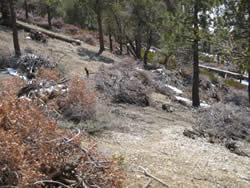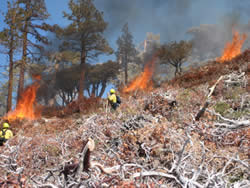
National Fire Plan Success Story
Big Pines Hazardous Fuels and Forest Health Project
Santa Clara-Mojave Rivers Ranger District, Angeles National Forest
National Fire Plan - Fuels Reduction
2008

Typical disbursement of vegetation after brush removal and pruning.

U.S. Forest Service personnel monitor pile burning on the Big Pines project. Managing vegetation today to avoid "the big one" tomorrow.
The Big Pines project is located on the Angeles National Forest near Wrightwood, CA, a community of over 2,000 people in the area between the Angeles and San Bernardino National Forests. Wrightwood has been threatened numerous times by large wildfires and is listed nationally as an at-risk community due to its location in the wildland-urban interface. Thousands more visit the area to recreate on weekends during fire season.
Among the main objectives of the project was to reduce vegetation along Big Pines Highway, one of only two routes into and out of Wrightwood and other high country areas. Reducing the presence and / or intensity of fire along this route by vegetative treatments is vital to ensuring a safe and effective evacuation of the public (and deployment of fire resources) during a large wildfire. Another aspect of the project involves reducing the presence and density of vegetation around organizational camps and recreational cabins located on National Forest lands along this same highway. These treatments essentially create defensible space around the camps and will allow firefighters to protect structures when the next wildfire occurs.
Implementation of the project began three years ago and is continuing. A variety of methods have been used to treat or remove vegetation. The main focus of the project thus far has been removing small diameter trees in overstocked areas to improve the health and vigor of the timber stand. The trees that are left have been pruned. In addition to thinning and pruning, firewood sales have taken place, to reduce biomass and provide fuelwood for mountain residents. Also, in some areas of the project, brush has been removed using chainsaws.
All the dead material has been either chipped or piled for burning. The focus of this year's activities has been the removal of the piles by burning, allowable only during prime conditions. Since January 1, 2008, approximately 2,700 (about 50% of the total) piles have been burned by U.S. Forest Service hand crews with some assistance from a local Cal Fire conservation camp. Completion of the burning is anticipated in April 2008.
Throughout the implementation phase of the project, Forest Service hand crews have been utilized, as well as engine crews, Cal Fire conservation camp crews and contract crews. Approximately 1,200 acres on the ground have been treated.
Contact: Karen Bauman, Fuels Officer for the Santa Clara-Mojave Rivers Ranger District, 661-296-9710 x243.